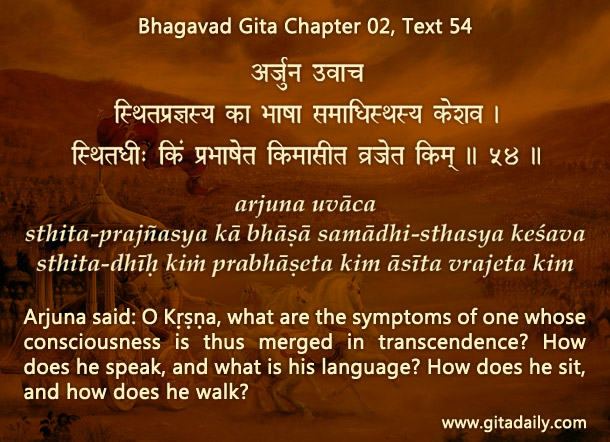In the Bhagavad-gita’s second chapter, Krishna outlines the process of working with detachment (karma-yoga). He concludes by describing the state of spiritual perfection, where one is beyond all temptations, be they earthly or heavenly (02.52-53).
As this description seems abstract, Arjuna seeks a more concrete picture of the self-realized by asking about their characteristics. The way he phrases his question highlights the Gita’s poetic stature, reflective of its name “The song of God.” Because the Gita contains philosophy, and profound philosophy at that, we may tend to forget that it is also a literary work in the genre of poetry. And poems frequently use figures of speech, thereby seamlessly blending the literal and the non-literal. Arjuna’s question demonstrates this smooth transition from the literal to the non-literal when he asks a four-part question: “What is their language? How do they speak? How do they sit? How do they walk?”
Consider the last part of Arjuna’s question: if taken literally, it implies that all self-realized people share a particular style of walking. That sounds patently absurd. Are they like models walking flashily on a fashion ramp? Certainly not. The words ‘walk’ and ‘sit’ are used here in the non-literal sense: walking refers to engaging their senses and sitting refers to restraining their senses. The question is especially pertinent because Krishna has mentioned that the path to enlightenment requires detachment from the results of work, but not necessarily renunciation of work itself. With that in mind, Arjuna is unable to picture such enlightened souls: if they aren’t always renounced sages, then who are they?
The first part of Arjuna’s question about their language involves a sophisticated non-literal reading of the corresponding Sanskrit word ‘bhasha’: language (bhasha) is that which describes, and characteristics are what describe a person — thus ‘bhasha’ is used to refer to ‘characteristics’. The second part of Arjuna’s question about their speech refers to their verbal responses to life’s ups and downs.
One-sentence summary:
The Gita’s seamless blend of the non-literal with the literal highlights its poetic stature.
Think it over:
- How does Arjuna’s second question highlight the Gita’s poetic stature?
- What’s wrong with a literal reading of Arjuna’s question?
- What does Arjuna’s four-part question actually mean?
***
02.54: Arjuna said: O Krishna, what are the symptoms of one whose consciousness is thus merged in transcendence? How does he speak, and what is his language? How does he sit, and how does he walk?
To know more about this verse, please click on the image


Leave A Comment